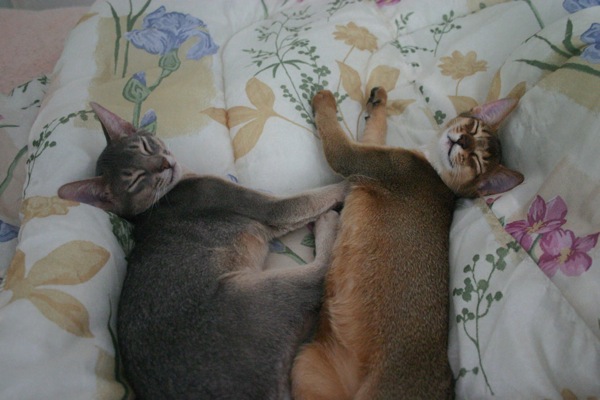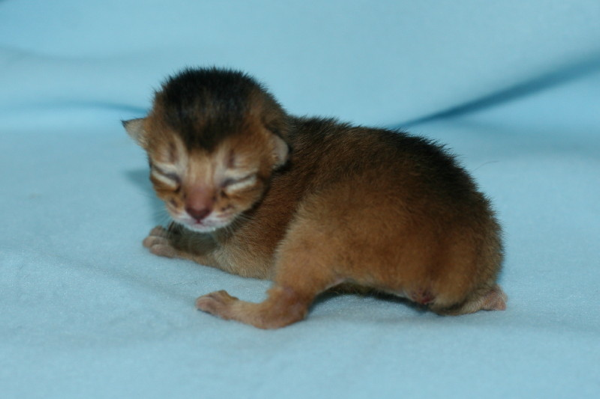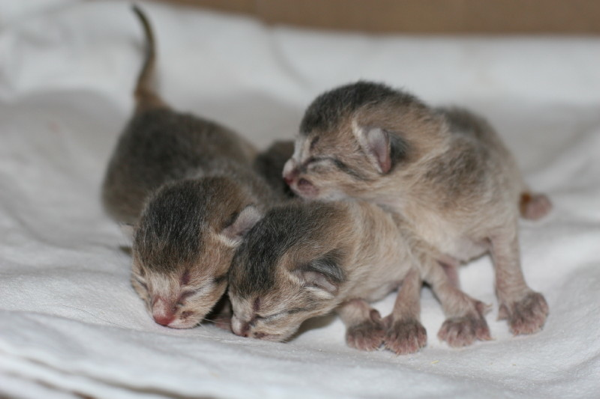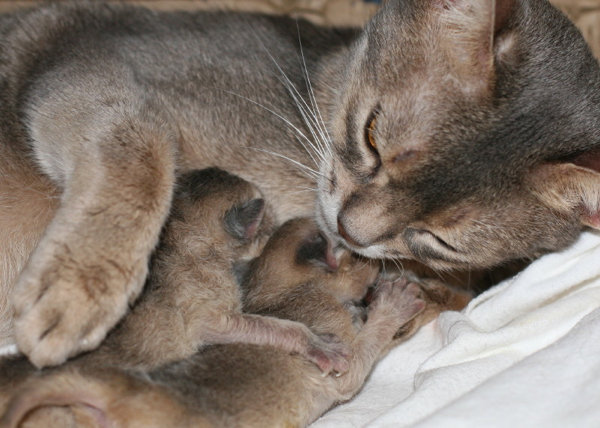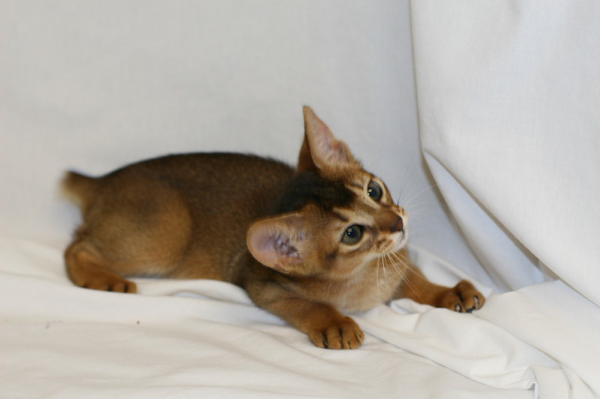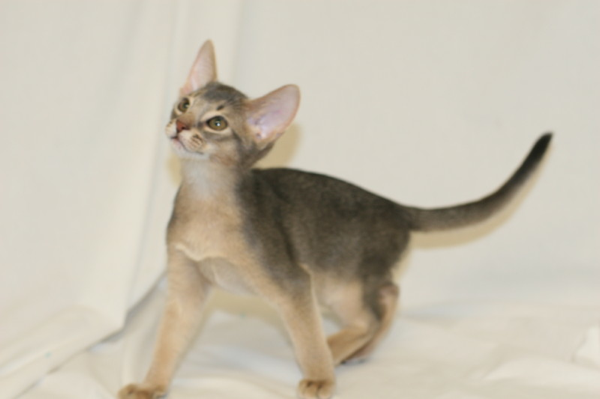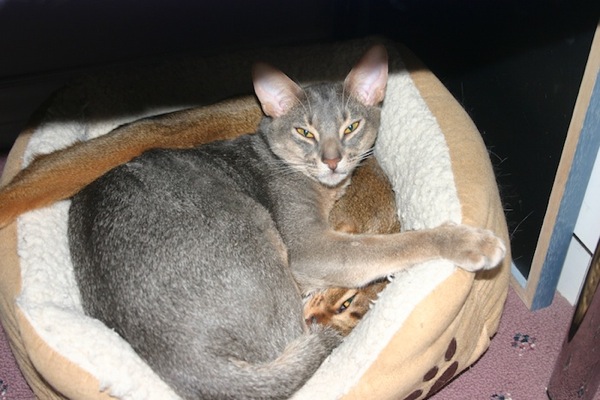We adopted two Abyssinian kittens in July of 2011. Samira is the ruddy (reddish-brown) girl, and Parushta is her blue (grey coloured) half-brother:
Unlike our other cats, Paru and Samira are “purebred”- a real oddity in a house full of moggies like ours. Why did we adopt pure bred cats, and why specifically Abyssinians?
Abyssinians: Feline energizer bunnies
Pretty much all cats are beautiful to me- even the odd looking ones. And almost every cat is “elitist” in its own way: the most ill-bred street cat still will carry itself as if it is royalty. There is no real benefit to breed “purity”, in my opinion. I’ve generally always adopted from shelters by preference: these are the cats that truly need homes. So deciding to go to a breeder for a specific “type” of cat is an anomaly for us.
This aberration comes in part from a period of challenge and sadness: months earlier we had brought two homeless kittens into our home, and their tiny lives were snuffed out by disease that could have been prevented. Harley and Jasmine broke my heart. I grieved for them, but even more intensely was left angry and frustrated: an underfunded no kill shelter had turned “kindness” into a death sentence for these kittens. After losing them we spent months and thousands of dollars testing and retesting to be sure our remaining cats were healthy: yes, they had been vaccinated all their lives, but vaccine is not perfect.
I briefly thought about not having any more cats. Logic would dictate that five cats in one house is more than enough. But that brief spurt of kittenish energy, crushed out prematurely though it was, had left a hole in our lives. Irene and I reminisced about a pair of year-old cats we had adopted from the Edmonton SPCA twenty years earlier that had both been energetic and fun. They were Abyssinian siblings, and we lost both prematurely. One, named Ember, disappeared a month or two after adoption: we lived on an acreage at the time, and we perhaps naively let our cats roam at will. The other suffered from a genetic disorder: renal amyloidosis. Mogwai lived with us for a year or so before succumbing to the condition.
We didn’t so much remember their sad loss, but rather their exuberant energy. It was this that got us thinking, then researching, and finally falling in love with Abyssinians. As a breed, they are considered highly energetic, athletic, and playful- even into adulthood. Lack of this kind of playfulness was a big part of the emptiness that we felt, and careful research of breeders would (we hoped) allow us to find truly healthy and happy individuals.
We found a breeder who seemed like a perfect fit for us. Abayomi Abyssinians is a family run business. Tracy, the breeder, wanted to meet us in person before we talked about adopting. We saw how the cats and kittens were raised: the beautiful and clean facilities, the males with their own special “house”, the small numbers, and the loving attention the kittens were receiving. We were “approved”, and picked out Samira and Parushta that day.
Baby pictures
One particularly odd experience about adopting from a breeder was being able to feel involved in every stage of the kitten’s life. We met both of the mothers (Burleah and Amara) and the father (Taiko, more formally “Ruddicat Head over Heels of Abayomi”) of our kittens. Tracy provided us with pictures of their first few weeks of life as well:
Samira: her Mom nipped her tail off as she was born
One of these is Parushta
Burleah and two of her three kittens: one may be Parushta
It was kind of fun to feel like we had been “involved” in Parushta and Samira’s entire lives, and to know that it had all been pretty good for them. Samira had a bit of a rough “day number one”: her Mom had nipped off her tail as she was born. It doesn’t seem to have made any real difference to Sami- she’s just as acrobatic as her brother, and her little “nub” is actually rather cute. And I’d like to think that the whole process of being born was traumatic enough that the loss of her tail maybe didn’t register very much for her.
Samira at about 10 weeks
Parushta at about 10 weeks
Speaking of registering, we have both Samira and Parushta registered: their full names are “Abayomi Samira Nubbins” and “Abayomi Parushta Strutsalot”. The other cats don’t seem very jealous 😉
Adult? Hardly…
Samira and Parushta are all grown up now. However, you would never know this from their behaviour. A normal day involves climbing every cabinet in the house, hiding in / pushing around /knocking over boxes and bags, and rumbling around the house, up and down stairs at breakneck speed.
Parushta loves to play fetch, but generally only when he initiates the game. He’s also a truly loving cat, head butting and purring the instant you touch him. He is also quite commonly curled up or sprawled out on Irene’s legs when she is reclining on our couch.
Samira is slightly more reticent: she has her “spots”, like when she’s in a box, or near the sink, or by a food bowl, when petting and purring are quite acceptable. However, most of the time she is racing around or curled up in one of her favourite “warm” spots, which generally do not include humans.
Both of them like batting and carrying things around. They have gradually stopped stealing every stuffed toy animal from Irene’s shelves, but only because we’ve given them a few of the “critters” to play with. One, a soft / floppy racoon about the size of a rolled up pair of socks, is part of a special game I play with them. The racoon is placed by me in various “high up” places around the house: on top of cupboards or shelves, the fridge, or something similar. The Abys then have to find him, and put him somewhere obvious like in the middle of the floor or at the foot of our bed. The game then repeats, with a different “hiding” place each time.
It is simple, but enjoyable fun 😉

